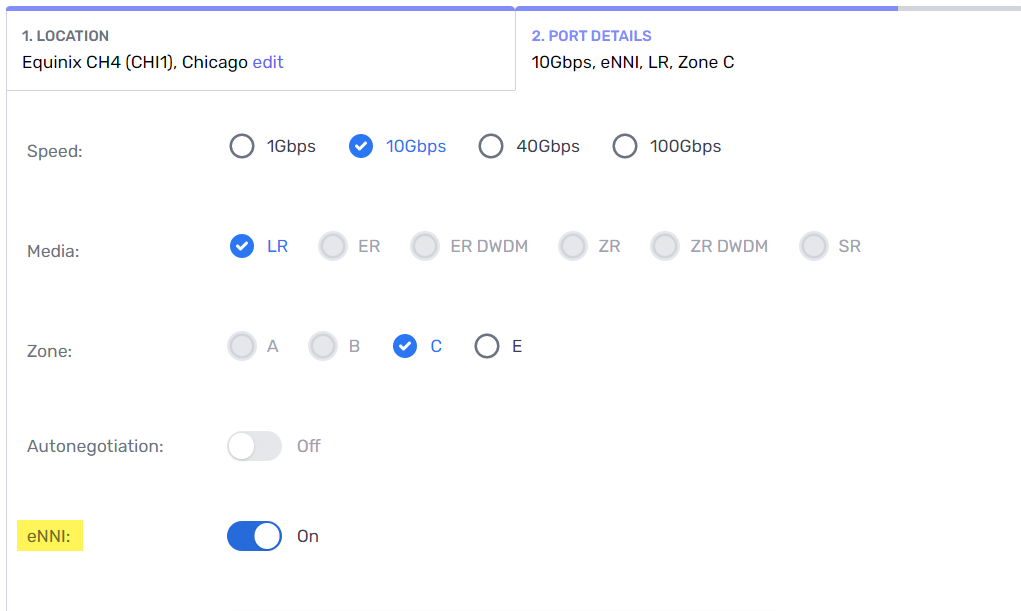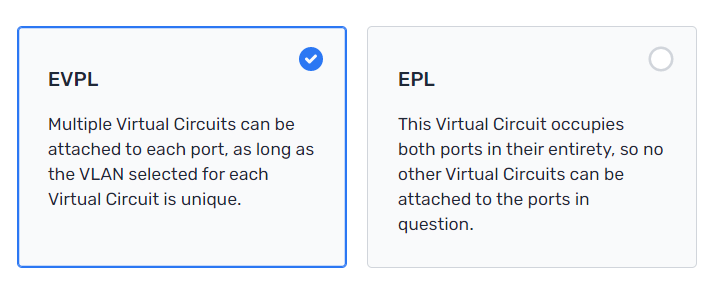-
Release Notes
- July 8, 2024
- May 22, 2024
- April 17, 2024
- March 20, 2024
- February 22, 2024
- January 18, 2024
- 2023 Releases
- 2022 Releases
-
2021 Releases
- December 20, 2021
- December 1, 2021
- November 22, 2021
- November 4, 2021
- October 26, 2021
- September 30, 2021
- September 22, 2021
- September 2, 2021
- August 16, 2021
- August 2, 2021
- July 19, 2021
- July 1, 2021
- June 17, 2021
- June 1, 2021
- April 30, 2021
- April 8, 2021
- March 25, 2021
- March 15, 2021
- February 25, 2021
- February 8, 2021
- January 28, 2021
- January 21, 2021
- January 13, 2021
- 2020 Releases
- Getting Started
- Ports
- Cross Connects
- Point-to-Point
- Virtual Circuits
- Cloud Connections
- Cloud Router
- Marketplace & IX
- Administration
- Billing
- Troubleshooting & FAQ
- Technical Reference
- Partners Portal
- API & Automation
ENNI Ports
An ENNI port is also known as an “external network-to-network interface,” as defined in MEF 26.
ENNIs allows Q-in-Q tunneling, also known as IEEE 802.1ad or “stacked VLANs.” While carriers commonly use this to manage customer traffic, individuals might have various uses for Q-in-Q as well.
For more information on business use cases, see ENNI Support for Q-in-Q, Network Extension and Backbone Expansion.
Provision an ENNI port
Create a port as you normally would. On the Port Details step, you will be given the option to create an ENNI port:

NOTE: By default, this option is not available to all users. If you want to see this option, contact support@packetfabric.com.
Also note that even when enabled, ENNI is not available at all locations.
Q-in-Q
With Q-in-Q tunneling, an Ethernet frame has two VLAN tags:
- C-VLAN - Also known as the “Customer VLAN.” This is the inner tag.
- S-VLAN - Also known as the “Service VLAN.” This is the outer tag.
You can use the S-VLAN to bundle and direct traffic, while still maintaining the C-VLAN identifier.
Technical notes
- The default TPID value is 0x8100.
- You cannot combine non-ENNI and ENNI ports together in a LAG.
- You can have multiple EPL virtual circuits on an ENNI port.
- To convert an ENNI port to a standard access port, you must contact support@packetfabric.com.
S-VLAN labels
Once you have an ENNI port provisioned, you can add labels to S-VLAN tags. For more information, see S-VLAN Labels.
Use case 1: ENNI to ENNI
This is essentially an EVPL connection.
Provider A has a customer who needs a virtual circuit between two locations on the provider’s network, and Provider A has NNIs with PacketFabric at those locations. Therefore, Provider A uses PacketFabric’s network to build the circuit.
Note the following:
- The S-VLAN is unique to the NNI termination and does not need to match between NNIs.
- If the customer wants different C-Tags to go on different EVCs then they must put the appropriate S-Tag on the frame. PacketFabric will not look at the C-Tag to steer traffic between two ENNI endpoints.
Click to expand:
Use case 2: ENNI to access port
Provider A has a customer who needs a virtual circuit between one of the provider locations and a location on the PacketFabric network. Provider A orders an access port for the customer and the cross connect is arranged.
Provider A then builds a virtual between their NNI and the access port. There are 3 combinations of delivery, shown top to bottom:
- EVC A - Untagged EPL access port to ENNI with an S-Tag and C-Tag, both of which must be removed at the ENNI.
- EVC B - Untagged EPL access port to ENNI with an S-Tag, which must be removed at the ENNI.
- EVC C - EVPL access port with C-Tag to ENNI with an S-Tag and a C-Tag. The S-Tag must be removed at the ENNI. C-Tag COS must be maintained.
Click to expand:
NOTE: If you are implementing the EPL scenarios, you need to ensure that your virtual circuit is an EPL. By default, virtual circuits are EVPL.
To make an EPL virtual circuit, select EPL under the Configuration step when creating a virtual circuit.

Use case 3: ENNI to cloud on-ramp
Provider A has a customer who needs a virtual circuit from one of the provider’s locations to one of PacketFabric’s cloud On Ramps. Provider A orders the cloud on-ramp virtual circuit.
Click to expand:
Updated on 25 Feb 2023


